#north aegean coast
Photo
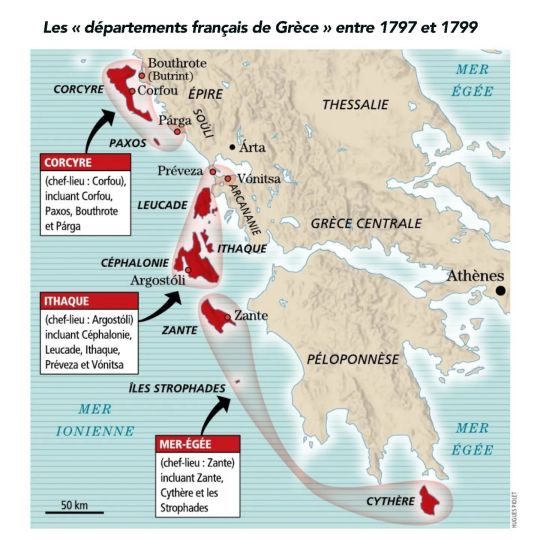
The Ionian Islands or “French departments of Greece” between June 1797 and March 1799
Revue « Historia » n°925, janvier 2024
by cartesdhistoire
By the Treaty of Campoformio (October 17, 1797), France acquired the formerly Venetian islands of the Lonian Sea, strategic bases which will help France to participate in the sharing, which is believed to be imminent, of the spoils of the Ottoman Empire: north to south, Corfu, Paxos, Lefkada, Ithaca, Kefalonia, Zante, plus Cythera to the south of the Peloponnese, and the numerous islets that separate them. Added to this are the Venetian establishments on the coast of Epirus: Párga, Arta, Préveza and Bouthrote.
It was Bonaparte himself who, by a letter to the Directory of 25 Brumaire Year VI (November 15, 1797), provided for the organization of these new French departments of Greece, three in number: Corcyra (with the capital of city of Corfu), Ithaca (with Argostóli as its capital) and Aegean Sea (with Zante, its capital, Cythera – the medieval Cerigo – and the quasi-desert archipelago of Strophades).
The French established a foothold in Kefalonia on June 28 and in Corfu on the 29th. The jurist Pierre–Jacques Bonhomme de Comeyras was responsible for administering the three departments from Corfu, as commissioner of the Directory. Provisional municipalities, with local notables known to be Francophiles, were set up as well as a departmental direction called the “Central”, not to mention, in parallel, a military administration, trying above all to control the French troops so that they did not does not behave like an army of occupation.
But, as part of the War of the Second Coalition, an offensive by the Russian fleet, acting on behalf of the Ottomans, took place from October 12, 1798 (battle of Nicopolis and capture of Préveza). Then followed, in order, the captures of Cythera, Zante, Ithaca, Kefalonia and Lefkada until November 27. Besieged Corfu resisted from November 18, 1798 to March 3, 1799.
In March 1800, the archipelago became the Republic of the Seven Islands, under the nominal authority of the Porte but under that, in reality, of Russian forces.
50 notes
·
View notes
Text
Мнемиопсис - древнейший, люминесцентный организм.
Mnemiopsis is an ancient, luminescent organism.
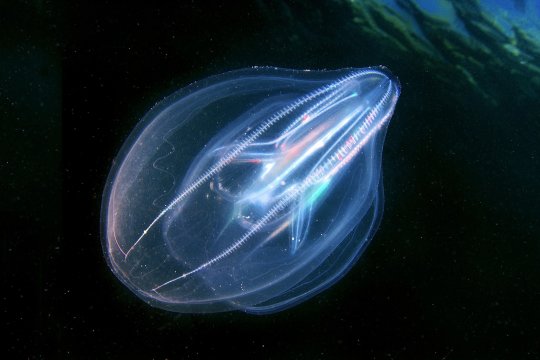
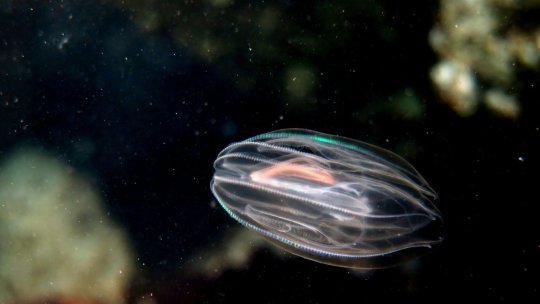

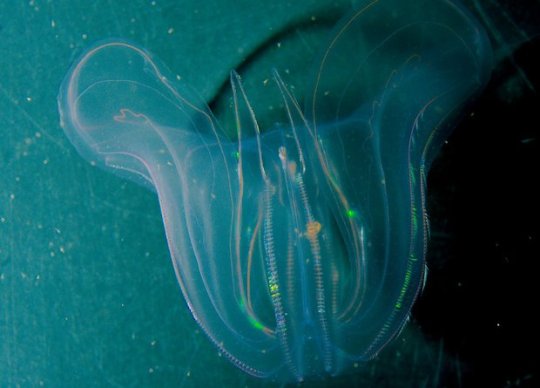


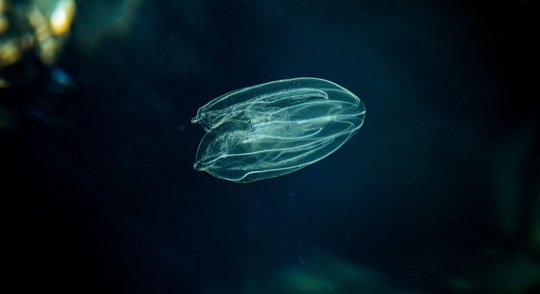
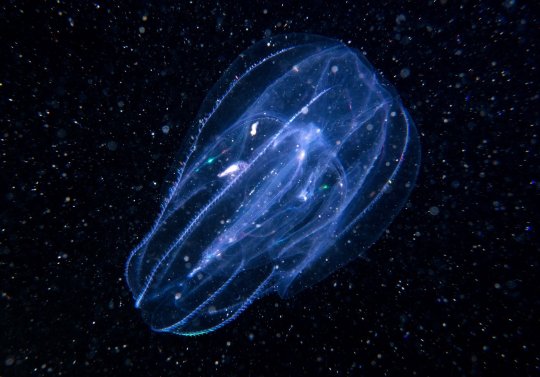


Гребневики не являются медузой, даже не имеют с ними родственных связей, хотя называть их по другому не выходит. Внешне мнемиопсисы легкие, прозрачные, с юбочками-лопастями и гребными пластинами. У них нет мозга, сердца, скелета, зато есть нервная система, орган равновесия и способность к люминесценции. Мнемиопсис – хищник, это плотоядное животное питающийся зоопланктоном, икринками, личинками рыб и моллюсков. На свету переливается яркими цветами, ночью придает морским волнам желтоватое люминисцентное свечение.
По самым последним данным ученых гребневик является одним из первых живых созданий на планете Земля. Ранее считалось, что этот титул принадлежит морским губкам — гораздо более примитивным существам.
Совсем недавно Гребневик Мнемиопсис (Mnemiopsis leidyi) – обитал лишь по ту сторону океана: вдоль восточного побережья Северной и Южной Америки, от Канады до Аргентины. Но, благодаря интенсивному судоходству, вместе с балластными водами он перебрался и в Европу. Как оказалось, гребневик может приспосабливаться к большому диапазону солёности. Теперь его ареал обитания включает Чёрное море, Азовское, Эгейское и Мраморное моря, западное побережье Швеции, даже почти пресное Балтийское море .
Ctenophores are not jellyfish, and they are not even related to them, although it is impossible to call them anything else. Externally, Mnemiopsis are light, transparent, with blade-like skirts and paddle plates. They do not have a brain, heart, or skeleton, but they do have a nervous system, an organ of balance, and the ability to luminesce. Mnemiopsis is a predator, a carnivore that feeds on zooplankton, eggs, and larvae of fish and mollusks. In the light it shimmers with bright colors, at night it gives the sea waves a yellowish luminescent glow.
According to the latest data from scientists, the ctenophore is one of the first living creatures on planet Earth. Previously it was believed that this title belongs to sea sponges - much more primitive creatures. More recently, the Ctenophore Mnemiopsis (Mnemiopsis leidyi) lived only on the other side of the ocean: along the eastern coast of North and South America, from Canada to Argentina. But, thanks to intensive shipping, it moved to Europe along with ballast waters. As it turns out, the ctenophore can adapt to a wide range of salinity. Now its habitat includes the Black Sea, the Azov, Aegean and Marmara Seas, the western coast of Sweden, even the almost fresh Baltic Sea.
Источник: telegram Океан,
nplus1.ru/news/2020/05/08/mnemiopsis,
/www.nkj.ru/archive/articles/23340/, /pikabu.ru/story/mnemiopsis__chuma_xxi_veka_4346622,/turizm.pibig.info/19015-grebnevik-v-chernom-more-mnemiopsis.html,
/ezoteriker.ru/grebnevik-beroe-v-chernom-more-mnemiopsis-chuma-hhi-veka-9-foto-mnemiopsis/,
//spadilo.ru/grebneviki-meduzy-ili-polipy/,
/dzen.ru/a/YbGQswZ7Y0VAg-7O,
/myanapa.ru/fauna/invertebrates/grebnevik/,
//seaforum.aqualogo.ru/topic/54177-гребневик-мнемиопсис-mnemiopsis-leidyi/.
#fauna#video#animal video#marine life#marine biology#nature#aquatic animals#sea creatures#Ctenophores#Mnemiopsis#luminesce#sea view#sea#beautiful#animal photography#nature aesthetic#animal gif#видео#фауна#природнаякрасота#природа#море#Гребневик#Мнемиопсис#люминесценция#планктон#гиф
65 notes
·
View notes
Text
Porphyrios

Since 2020 there have been over 400 run-ins with orca whales off the coast of Spain. So far, they've sunk at least three ships and damaged dozens more. A ship's skipper, Daniel Kriz, who has had the orcas damage rudders on two different boats he's been on, says they're getting better at it too.
“In 2020, the attack lasted almost an hour and was not as organized,” Kriz said. “This time we could hear them communicating under the boat. It only took about 10 to 15 minutes.”
Why are whales suddenly going after boats with such determination and for such a long span of time? Scientists are unsure, leaning between the whales retaliating for harm a ship did them previously or simply becoming brave enough in their curiosity to unintentionally damage ships. Perhaps I am a bit too influenced by stories I've read but I would tend to believe the orcas know exactly what they're doing.
I also know this isn't the first time a whale has attacked, or sunk, a ship.
Perhaps the most modern famous one is the sperm whale that sunk the whaling vessel Essex in 1820, an incident that inspired Herman Melville to write Moby Dick in 1851.
But we can go further back than that.
Much further.
Let's go back to sixth century Constantinople. According to Procopius, a historian of the time from Caesarea, a great whale, 45 feet (13.7 meters) long and fifteen feet (4.6 meters) wide haunted the Strait of Bosporus and the waters around it. This whale wasn't just there to sight-see either. The whale attacked and sank ships it came across.
The sailors of the time named the monster Porphyrios.
There's debate what the name was derived from (other than the gut kick reaction to shout 'oh shit!' the second you saw the whale hove into view) but most scholars think the whale's name came from prophyra which meant a deep, purple color. This could have been referring to the color of the whale's skin or perhaps imbuing it with some of the terrifying, regal nature that nobles of the time, the only ones allowed to wear the purple, implied. Whales weren't well known in that area of the world at that time and we have no way of knowing what kind of whale it was. Speculation based on size leads many to believe it was a lost sperm whale a long way from home but it might have also been a large orca. Iberian orcas hunt the Straight of Gibraltar, following the bluefine tuna every year and they're the ones responsible for the recent ship attacks off the coast of Spain of the past few years. It's not hard to imagine one of them wandering east, deeper into the Mediterranean Sea, instead of heading back north when the tuna left. And Porphyrios didn't just set up shop anywhere. He decided that the Strait of Bosporus was his new hunting ground.
Here's the thing. The Strait of Bosporus was the main trade route for that part of the world. Goods flowed down to the Black Sea, crept through the narrow Strait of Bosporus which let out into the Sea of Marmara. One more strait, this one the Dardanelles, where the city of ancient Troy once controlled all trade out of the East, and then it was out into the Aegean Sea and then on to the Mediterranean. Trade goods could pass by on land but it added both dangers and time to the business and, most importantly, took all that sweet, sweet toll to use their water passage right out of Constantinople's hands. Having what amounted to a sea monster living in their main money-maker and convincing merchants to find other ways to bypass the strait, and therefor the city sitting on the edge of it, was disastrous for a country that was trying to restore itself to its former glory. Emperor Justinian I, also known as the Great, put out a bounty on the monster's head and did everything in his power to encourage its capture or eradication.
The tools of whaling used centuries later to drive many whale populations to the brink of extinction however were unknown at the time. Porphyrios shrugged off the arrows and spears lobbed at it and went on sinking ships, sending simple fishing vessels to the bottom of the ocean just as steadily as it did merchant and war ships. There was even a story that Justinian's famous general, Belisarius, loaded a catapult onto a ship to hunt the deadly whale, though this seems to be just a story and one which also failed to killed the great monster of the strait.
Porphyrios becoming a terror that merchant captains probably saw in their nightmares even when they were on dry land. Long routes far out of the way were taken to avoid waters he swam in. There would be lulls. For unknown reasons, Porphyrios would disappear for long periods of time, lulling ship captains and their crews into thoughts that the monster had died. It never lasted though and for over fifty years, Porphyrios hunted the ships of the Bosporus and its surrounding waters, damaging some and sending many more to the bottom of the ocean.
Nothing lasts forever though. One day, the story goes, Porphyrios was chasing dolphins in the Black Sea and ran aground. Struggling to get back to deeper water, it only churned up the dirt, sinking itself more completely into the mud. Locals that lived nearby saw what was happening and ran out to kill the great beast but their axes did little damage against its tough hide. In the end, they lashed ropes to to the whale and, using horses and wagons, dragged its great bulk to higher ground. There they finally managed to kill the beast, eventually hacking it to bits and eating the pieces. Porphyrios, killer of men and sinker of ships, terror of the Bosporus, was no more.
It was the first recorded case of a whale attacking ships.
It hasn't been the last.
Perhaps the Iberian orca, social animals that can teach each other how to disable and sink ships, tell stories, late at night when they rest in the waters off the coast of Spain, with the bright lights from the shore twinkling above the water like electric stars. Perhaps they tell stories of an ancestor who hunted strange waters -
and taught the humans in their noisy ships above what real fear was.

#porphyrios#whale#whales#orca#sea monster#history#constantinople#justinian#killer whales#orcas#turkey#bosporus strait
10 notes
·
View notes
Note
oooOOOooooo haunting Sheriff with information about Turkey the country that borders the Black Sea to the north; Georgia to the northeast; Armenia, Azerbaijan, and Iran to the east; Iraq to the southeast; Syria and the Mediterranean Sea to the south; the Aegean Sea to the west; and Greece and Bulgaria to the northwest, with Cyprus off the south coast oooOooOOOoo im the Turkey ghooooost
Leave me alone!
15 notes
·
View notes
Text
So I was nerding around this morning, and I realized, somehow for the first time, that Troy effectively guards the entrance to the Dardanelles (Strait of Gallipoli/Hellespont), which would make it one of the most strategic locations in the ancient world. How did I not know this? Am I mistaken? How far would it have been from the shore in ancient times? This seems important?
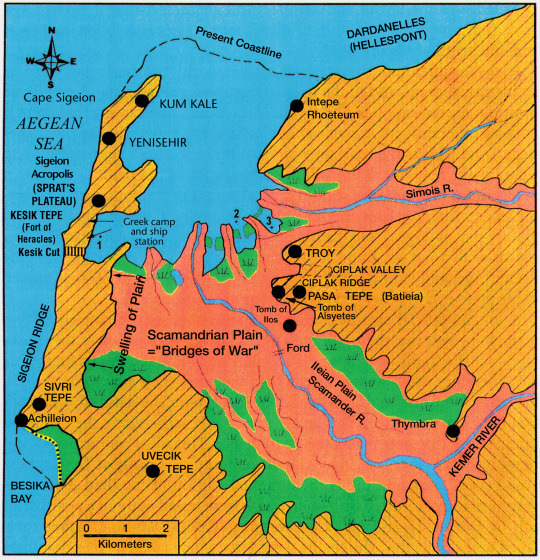
Map from University of Delaware.
ETA:
Inhabited from the Early Bronze Age (3000 BCE) through to the 12th century CE the archaeological site which is now called Troy is 5 km from the coast but was once next to the sea. The site was situated in a bay created by the mouth of the river Skamanda and occupied a strategically important position between Aegean and Eastern civilizations by controlling the principal point of access to the Black Sea, Anatolia and the Balkans from both directions by land and sea. In particular, the difficulty in finding favourable winds to enter the Dardanelles may well have resulted in ancient sailing vessels standing by near Troy. Consequently, the site became the most important Bronze Age city in the North Aegean, reaching the height of its prosperity in the middle Bronze Age, contemporary with the Mycenaean civilization on the Greek mainland and the Hittite empire to the East.

--from World History Encyclopedia
3 notes
·
View notes
Photo


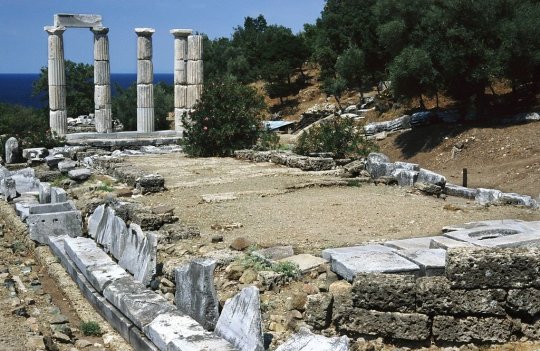
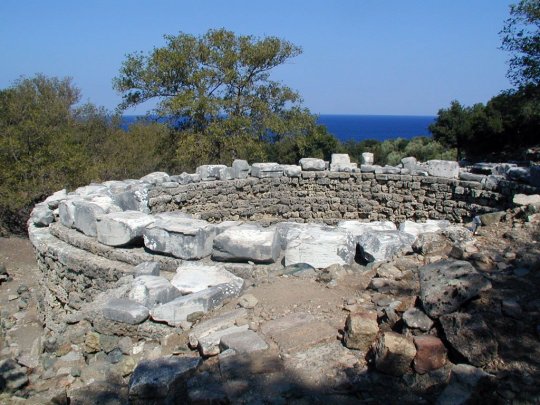
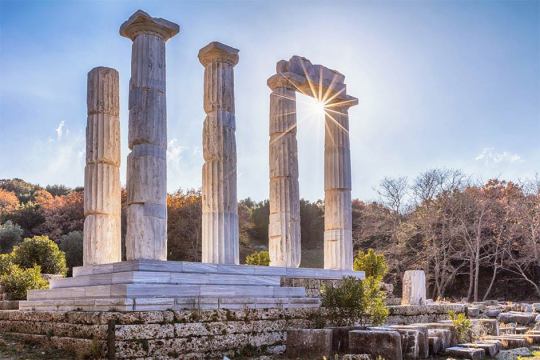




The Ancient Greek Sanctuary of Samothrace
Samothrace, a small, rocky Greek island in the northern Aegean Sea, has a storied past that belies its diminutive size. One of the most rugged of all the Greek islands, its Mt. Saos rises to 1,611 meters (5,285 feet).
Known best for its Sanctuary of the Great Gods, or Hieron ton Megalon Theon, in Paleopolis, it was once the home of the stunningly beautiful 2.5-meter (8.2-foot) tall marble statue of Nike, created in 190 BC, now known as the “Winged Victory of Samothrace.”
Like so many other of Greece’s ancient treasures, it now is displayed in a European museum (in this case, the Louvre in Paris); but it was once part of the Sanctuary, whose remains still grace the island today.
Found in pieces in the ground by the French archaeologist Charles Champoiseau, the sculpture is recognized universally as one of the most arrestingly beautiful in all the world.
The ancient city on Samothrace, the ruins of which are called Palaeopolis (“old city”), was situated on the north coast of the island. Much of its ancient walls, which were built in massive Cyclopean style, are still extant.
Traditional accounts from antiquity state that the island of Samothrace was first inhabited by Pelasgians and Carians, and later Thracians. At the end of the 8th century BC the island was believed to have been colonized by Greeks from Samos, hence the name Samos of Thrace, which later became Samothrace.
The Samothrace Temple Complex served as one of the major pan-Hellenic religious sanctuaries; it was also a center for its own mystery religion which was open to the worship of all, not just a select few initiates.
The temple complex, which was visited by a panoply of notable figures from the past, including Lucius Calpurnius Piso Caesoninus, the father-in-law of Julius Caesar, was mentioned by Plato and Aristophanes.
The cult of the mysterious, unnamed “Great Gods” on Samothrace
During the Hellenistic period, after the investiture of Phillip II, it formed a Macedonian national sanctuary. It remained an important religious site throughout the Roman period, with the Emperor Hadrian visiting Samothrace at one point during his reign.
Samothrace still has some of its ancient mysteries intact, with historians still trying to discover the identity and nature of the deities venerated at the sanctuary. This is in large part because it was taboo to even pronounce their names in ancient times.
Literary sources from antiquity refer to them under the collective name of “Κάβειροι,” or Kábiroi), while they are also known by the simpler epithet of “Great Gods.”
The Pantheon of the Great Gods at Samothrace consists of numerous chthonic deities, meaning those having to do with the underworld. This incredibly even predated the arrival of Greek colonists on the island in the 7th century BC.
Earth Mother deity central at Samothrace
The Earth Mother, or Great Mother, a goddess often depicted on Samothracian coinage as a seated woman, with a lion at her side, was the central deity at the sanctuary. Fortunately, her secret name, Axiéros, is known to us today. The Greeks associated her with the goddess of fertility, Demeter.
Hecate, under the name of Zerynthia, and Aphrodite-Zerynthia, two important nature goddesses, are equally venerated at Samothrace, although their cult was distanced from that of the Great Mother and more closely identified with deities more familiar to the Greeks, according to historians.
Kadmilos (Καδμίλος), the spouse of Axiéros, is a fertility god identified by the Greeks as Hermes; he was a phallic deity whose sacred symbols were a ram’s head and a baton (kerykeion), which can even be found on some currency.
Two other male deities accompany Kadmilos; these may be the two mythical heroes who are credited with founding founded the Samothracean mysteries: the brothers Dardanos (Δάρδανος) and Iasion (Ηετίων). They were associated by the Greek people of the time with the Dioscuri, the divine twins who were known as protectors of mariners in distress.
Mariners navigating around Samothrace left offerings to the gods
And that would be fitting, since ancient Greek mariners were known to leave offerings at the site of the sanctuary on Samothrace in order to secure their safe passage around the rocky island.
The sanctuary was open to everyone who wished to worship the Great Gods, unlike other sanctuaries in ancient Greece, which would only be opened to certain initiates. The rituals and ceremonies at Samothrace were presided over by the priestess; its head priestess, who was often a prophetess, had the title of “Sybil,” or “Cybele.”
Prayers and supplications at the sanctuary would be accompanied by blood sacrifices of domestic animals, including sheep and pigs, whose carcasses were burned in sacred hearths, as well as libations made to the deities.
Many altars made of rock were used for these purposes, the largest of which was surrounded by a monumental enclosure at the end of the 4th century BC.
The major annual festival on Samothrace, which drew envoys to the island from throughout the Greek world, most likely took place in mid-July. Consisting of the presentation of a sacred play, which entailed a ritual wedding, this may have taken place in the building with the Dancer’s Wall, which was built in the 4th century BC.
Around the year 200 BC, a Dionysian competition was added to the festival, facilitated by the construction of a theater in the complex.
Many votive offerings were made at the sanctuary, which were placed in a building made for that purpose next to the great altar; typical offerings could have been statues of bronze, marble or clay, as well as weapons or vases.
The first stage of the initiation rites into the Samothracian mysteries was the “myesis.” A sacred story and special symbols were revealed to the initiate; during the ceremony he or she would receive a crimson sash tied around the waist which was meant to be a protective talisman.
An iron ring exposed to the divine power of magnetic stones on the island was most likely another symbol of protection conferred during the initiation, archeologists believe.
The sanctuary on Samothrace consists of three narrow terraces on the west slopes of Mount Hagios Georgios, separated by two steep-banked streams. The entrance is through the Ptolemy II propylaeum, also known as the Ptolemaion, which spans the eastern brook like a bridge.
A winding path then descends towards the main terrace, sited between two brooks, where the main monuments of the sanctuary are found. A large tholos, the Arsinoëion, or Arsinoë Rotunda, is the largest covered round space in the ancient Greek world.
Measuring an incredible 20 meters (65 feet) in diameter, it may have served to welcome the theoroi, the sacred ambassadors sent by cities and associations to attend the great festivals at the sanctuary.
Building of the Dancers Frieze marks even more ancient sacrificial area
The Building of the Dancer’s Frieze, the largest at the Sanctuary, constructed on an even older sacrificial area, is located at the opening of the path leading to the site.
The most important building of the cult, the Epopteion, is located to the south of the Temenos. This building bears the inscription of Hieron. The interior boasts the largest unsupported span in the ancient Greek world – 11 meters (36 feet).
The Anaktoron, the building for greeting the religious initiates, is located north of the Arsinoë Rotunda.
The third and final terrace, west of the spiritual center of the sanctuary, is primarily occupied by buildings for offerings, such as the Miletean Building, dedicated by a citizen of Miletus, and the Neorion, or naval monument. It is also the location of what as once a banquet hall.
The space above all of these buildings is dominated by an enormous portico measuring an astounding 104 meters (341 feet) long; this acts as a monumental backdrop to the entire sanctuary.
The remains of a square Byzantine fort is also in this area; it was constructed of re-used building material from the original site.
Strong ties to Macedonia, Philip II and his wife Olympias
The historian Plutarch, in his work “Life of Alexander,” says that Philip of Macedon, later to become the father of Alexander the Great, was initiated into the mysteries of Samothrace at the same time as Olympias; he immediately fell in love with her and betrothed himself to her at once.
The first sovereign of whom epigraphic traces remain was the son of Philip II and half-brother of Alexander, Philip III of Macedon, who would become the principal benefactor of the Sanctuary during the 4th century BC.
The second surge of major construction started in the 280’s BC with the building of the Arsinoe II Rotunda, which may date from 288–281 BC, when this daughter of Ptolemy I was married to the Diadochi Lysimachus, who was then king of Macedon.
Philip V of Macedon, the last Antigonid king to attempt to establish a Macedonian thalassocracy, or seaborne empire, had a monumental column dedicated to him in front to the large stoa of the upper terrace by the Macedonians by the year 200 BC.
“Winged Victory” statue created around 200 BC
Historians believe that it was probably during one of these episodes that the monumental fountain containing a ship’s prow of limestone — and the masterpiece of the Winged Victory of Samothrace statue — were created.
During the Roman and particularly the imperial period, thanks to the interest of the Roman emperors, Samothrace became an international religious center, where pilgrims flocked from all over the Roman world.
The island is mentioned in the Bible, with the name Samothracia; the Book of Acts records that the Apostle Paul, on his second missionary journey, sailed from Troas to Samothrace and spent one night there on his way to Macedonia.
The Ottoman Empire conquered the island in 1457. An insurrection against them by the local population during the Greek War of Independence (1821–1831) led to the wholesale massacre of 1,000 Samothracians.
Excavations of sanctuary continue down to present time
Following the 1863 discovery of the Winged Victory, by French consul Charles Champoiseau, who was based out of Adrianople, the French team of Deville and Coquart carried out the first archeological excavation of Samothrace three years later, in 1866.
Austrian archaeologists were the next on the scene, uncovering the Ptolémaion and the stoa in 1873 and 1876; they also carried out some superficial excavations of the Hiéron and the Arsinoéion as well as the Temenos.
As part of an agreement they signed with the Ottomans, the Austrians divided what would now be considered the plunder of the site between Vienna’s Kunsthistorisch Museum, museums in Gallipoli and the Istanbul Archeological Museum.
And, as always seemed to happen in Greek discoveries, some of the objects disappeared on the way to these institutions — never to appear again publicly.
Champoiseau returned to Samothrace in 1891 to search for the blocks which formed the ship’s prow upon which the Winged Victory statue had been installed in Paris; while there he discovered the theater that had been constructed in 200 BC as part of the Dionysian competition.
The Institute of Fine Arts of New York University started its first excavations in 1938, as a result of which which the Anaktoron was unearthed. Interrupted by World War II, during which time the site suffered greatly as a result of Bulgarian occupation, they returned to Samothrace in 1948; their excavations continue to the present day.
By Patricia Claus.
#The Ancient Greek Sanctuary of Samothrace#statue#statue of Nike#winged victory of samothrace#archeology#archeolgst#ancient artifacts#history#history news#ancient history#ancient culture#ancient civilizations#ancient greece#greek history#roman history#long reads
133 notes
·
View notes
Text
The Chronicles of Lathsbury -> CRASH COURSE
Part 4: The Setting & Major Cities
I want to preface this by saying I am STILL struggling to make a TCOL map bc map making is hard and I don’t know how to go about it. We’re working on it. As it stands though, Terrae is a large landmass with 2 medium sized islands off of its Western coast (separated from Terrae by The Eastern Sea… its a very Iceland/Greenland thing): Diisai and Kiskkaddon. All three land masses are under the jurisdiction of The Kingdom of Lathsbury. It’s a parliamentary monarchy with very distinct city-states that function as hubs of influence and culture. Most Terraneans refer to themselves, “nationally” or “ethnically” as being from whatever city they were raised in (not necessarily born—it depends on person to person). It would be similar to say, someone who lives in California saying “I’m human but I’m Californian.” People of Terrae will say: “I’m Diisian” or “I’m Veilian.” As examples.
There’s a lot of small villages and townships that exist around Terrae but these are the major cities that either play a role in the story or are mentioned with some relative frequency. I’ll include a brief description as well as what people call themselves who are from there:
LATHSBURY (Lathsburian): Lathsbury is the capital of The Kingdom of Lathsbury and is named after the first Guardian of Terrae, Lath. It’s known for its entrance to The Labyrinth, it’s bustling and diverse culture as it’s a huge traveling and trading hub, for its Guilds, and being the base of all government operations.
KINGSBURROW (Lathsburian): As Kingsburrow was established near the same time, and has close proximity to Lathsbury, most people who live in Kingsburrow consider themselves to be Lathsburian. It’s known for its rich mineral deposits and mining culture.
EROS / ARGOS (Aegean): The swampy, dense Eros is a converted fortress city that stands in the shadow of the crumbling and foreboding Argos—the first capital and city of Terrae thousands of years ago. Eros is known for its hunters and dark hunters, and their seemingly never ending devotion to culling the vast chaos that lies beneath Argos’s dilapidated streets, in hopes of one day reclaiming the city and restoring it to its former glory.
MARTHVEIL (Veilian): Marthveil is the birthplace of alchemy and a hub of innovation, and is the most technologically advanced city in all of Terrae, with electric lighting being one of its main highlights. It’s named after the god of alchemy MARTH who was born in the region.
HYTRÖTH (Püerthian): Hytröth lies at the foot of the sacred Mt. Hytröth, which is also known as MUINENS’s home. It’s no surprise that the Protector’s Academy and the largest OOM Temple are located here. They call themselves Püerthian because they are sheltered under the towering Mt. Hytröth from the worst of the north’s pain.
SILVERKEEP (Silvian or Lathsburian): The hub of medicinal research in Terrae due to the incredible and sheer vast biodiversity of plants that can be found nowhere else in Terrae. They call themselves Silvian however, implants from Lathsbury are extremely common so it’s more of a blended culture.
DIISAI (MORDIGA) (Diisaian): The larger of the two islands off of Mainland Terrae’s western coast, Diisai (and it’s capital city Mordiga) is the hub of harvest, food and drink. It’s known for its beautiful rolling hills and it’s residents are known to be quite superstitious. As an aside, they are also known for having particular accents and for us humans it’s very similar to a Scottish/Gaelic accent.
KISKKADDON (Kisks): The smaller of the two islands off of mainland Terrae and desert land throughout. Closer to the sea lies a rocky temperate desert which transitions into a full tropical desert inland. It is notoriously difficult to survive in, with more and more migrants coming from Kiskkaddon to mainland Terrae each year as the desert expands.
SNAKE’S CANYON (Illumese): On the Eastern edge of the continent lies the dark badlands of Snake’s Canyon. They are known for their canyon built homes and the guild class, Illuminators or Hexers. The entire northeast where Snake’s Canyon lies is usually covered in a permanent dusk or darkness.
WISH OF PALANTHIA (Palanthian): The residents of Wish of Palanthia are known for their kindness, generosity, and agreeable nature. The city is famous for being the site where a peace treaty was signed after the first and last Terranean civil war. Etched in stone in the center of the city is the grim promise the city stands to uphold: Should Terraneans ever war amongst themselves again, IISIDIA will destroy all life on Terrae.
BASS LANDING (Canterian): Taken from cantatio, the Canterian people of Bass Landing are famous for their music and arts.
EASTHOLLOW (n/a): Easthollow lies close to Eros and the Western coast and is nicknamed “The Guild City” as any willing adventurer must travel to Easthollow to pass the Guilder’s exams and be chosen in the guild bid before they can become a guild hand proper. The city is called “hollow” because there are no permanent residents that reside here; and as such it has no significant cultural heritage.
UBWYN (THE CITY OF SORROWS) (n/a): Ubwyn is mostly a ruin now, but it was the first place the Nomads that would eventually become The Lathsburians established after they fled from Eros after The Day of Fissures. It’s mostly remembered as a cultural site, and some say they do occasionally see what seems to be a tall, pale, ghostly woman floating among the ruins at night.
16 notes
·
View notes
Text
Events 1.3 (before 1960)
69 – The Roman legions on the Rhine refuse to declare their allegiance to Galba, instead proclaiming their legate, Aulus Vitellius, as emperor.
250 – Emperor Decius orders everyone in the Roman Empire (except Jews) to make sacrifices to the Roman gods.
1521 – Pope Leo X excommunicates Martin Luther in the papal bull Decet Romanum Pontificem.
1653 – By the Coonan Cross Oath, the Eastern Church in India cuts itself off from colonial Portuguese tutelage.
1749 – Benning Wentworth issues the first of the New Hampshire Grants, leading to the establishment of Vermont.
1749 – The first issue of Berlingske, Denmark's oldest continually operating newspaper, is published.
1777 – American General George Washington defeats British General Lord Cornwallis at the Battle of Princeton.
1815 – Austria, the United Kingdom, and France form a secret defensive alliance against Prussia and Russia.
1833 – Captain James Onslow, in the Clio, reasserts British sovereignty over the Falkland Islands.
1848 – Joseph Jenkins Roberts is sworn in as the first president of Liberia.
1861 – American Civil War: Delaware votes not to secede from the United States.
1868 – Meiji Restoration in Japan: The Tokugawa shogunate is abolished; agents of Satsuma and Chōshū seize power.
1870 – Construction work begins on the Brooklyn Bridge in New York, United States.
1871 – In the Battle of Bapaume, an engagement in the Franco-Prussian War, General Louis Faidherbe's forces bring about a Prussian retreat.
1885 – Sino-French War: Beginning of the Battle of Núi Bop.
1911 – A magnitude 7.7 earthquake destroys the city of Almaty in Russian Turkestan.
1911 – A gun battle in the East End of London leaves two dead. It sparked a political row over the involvement of then-Home Secretary Winston Churchill.
1913 – An Atlantic coast storm sets the lowest confirmed barometric pressure reading for a non-tropical system in the continental United States.
1913 – First Balkan War: Greece completes its capture of the eastern Aegean island of Chios, as the last Ottoman forces on the island surrender.
1920 – Over 640 are killed after a magnitude 6.4 earthquake strikes the Mexican states Puebla and Veracruz.
1933 – Minnie D. Craig becomes the first woman elected as Speaker of the North Dakota House of Representatives, the first woman to hold a Speaker position anywhere in the United States.
1944 – World War II: US flying ace Major Greg "Pappy" Boyington is shot down in his Vought F4U Corsair by Captain Masajiro Kawato flying a Mitsubishi A6M Zero.
1946 – Popular Canadian American jockey George Woolf suffers a concussion during a freak racing accident; he dies from the injury the following day. The annual George Woolf Memorial Jockey Award is created to honor him.
1947 – Proceedings of the U.S. Congress are televised for the first time.
1949 – The Bangko Sentral ng Pilipinas, the central bank of the Philippines, is established.
1953 – Frances P. Bolton and her son, Oliver from Ohio, become the first mother and son to serve simultaneously in the U.S. Congress.
1956 – A fire damages the top part of the Eiffel Tower.
1957 – The Hamilton Watch Company introduces the first electric watch.
1958 – The West Indies Federation is formed.[
1959 – Alaska is admitted as the 49th U.S. state.
2 notes
·
View notes
Note
who like beach more? K or Ben?
My Kylo/Ben interpretations appreciate different oceans for different reasons. However, none would take off and run into it like me! None of them dance with the ocean. They don't know the steps, when to dive, when to coast, when to tread, and Music/Modern!Ben, in particular, has no love for those 14 bays off the Atlantic, the Atlantic's color, torrent, coldness, and devilish playfulness —also re. Modern!Ben, he's not a strong swimmer. (With his height, I'd have made the Olympics. No, I'm lying, I never trained that hard.)
He doesn't dive into the mischievous surf; he doesn't float on its endless belly and bask with it in the sun. He doesn't cackle (generally) when sand crabs nip his toes or when small fish and seaweed from the barrier beach slither through his fingers. Ben sees the Atlantic and fears its temper and its secrets. He doesn't want to know its tides… the sediments that roll away, the dropoffs. Ben couldn't be comfortable knowing there are sharks all up and down the Rockaways… he wouldn't be sad for all those sharks swimming up from the boiling waters further down south. (He would be sad for the world.) I don't know that he'd even get in that New York dirty water. (Past the knee? He's the type to fall asleep in the sun and get burnt BADLY and UNEVENLY.)
Ben likes Sardinia (the seas Meditteranean and Tyrrhenian) and Thásos (Aegean, the sea of my people). Ben likes the Black Sea. Ben likes the Pacific. Who wouldn't? Me too, but I love my aggy North Atlantic with ~*that nasty ass New Yoahk wawtah.*~ I love the tempestuousness and impetuousness and Peter Pan-ness of its terrible waves. I float on my back, laying on top and inside of it, when it allows me, and it allows me because I know it well enough, my beautiful** and dangerous friend.
Yup! Anyways, here's a random article about one of NYC's beaches: The Mystery of the Fish Living in Riis Beach's Abandoned Hospital - The future is uncertain for Riis's Queer Beach and the fish who live there.
2 notes
·
View notes
Text
APRIL 2024 CHICAGO ARCHAEOLOGY LECTURES AND EXHIBITS
LECTURES
April 11, 7:00 PM
AIA Society Chicago Lecture
"Crouching Tigers, Hidden Elephant”
Lecturer: Noel Tan
While a global phenomenon, rock art has been a relatively recent subject of study in Southeast Asia with the number of known sites growing from a handful in the 1960s to over a thousand today. Research accelerated in the last 20 years with better recording and analytical techniques as evidenced by the increased number of papers on Southeast Asian rock art in international conferences and journals since the 2000s. The majority of sites are located from Indonesia and Thailand, where sustained episodes of research have been conducted. New dates from Indonesia challenge long-standing ideas about the ‘origin’ of art while other discoveries shed light on the movements and activities of peoples across this diverse landscape. This lecture presents a survey of rock art across Southeast Asia from the deep past to more modern times and shows how rock art can help us better understand the archaeology of Southeast Asia.
DePaul University Levan Center
2322 North Kenmore Avenue
Chicago
April 13, 5:00 PM
American Research Center in Egypt (ARCE)
Chicago, Illinois Chapter
"New Evidence of the 25th Dynasty God’s; Wives of Amun at Luxor Temple”
Catherine Witt, Egyptology PhD Candidate at the University of Chicago
In Person only in the LaSalle Banks Room at ISAC
This year there is one lecture, 20 minutes long
(in keeping with the ARCE Meeting lecture format)
so this will be a short meeting.
April 17, 8:00 pm ET, 7:00 PM CT
AIA Society, Chicago Online Lecture
This is an online event.
"Excavating a Shipwrecked Marble Column Destined for the Temple of Apollo at Claros"
Deborah Carlson (Texas A&M)
Between 2005 and 2011, researchers from the Institute of Nautical Archaeology at Texas A&M University excavated and raised the remains of an ancient ship that was wrecked off the Aegean coast of Turkey at Kızılburun in the first century B.C. This ship was transporting about 60 tons of white marble blocks and architectural elements that originated in the quarries on Proconnesus Island in the Sea of Marmara. Ceramic artifacts and coins help narrow the date of the shipwreck, but the pieces of a single monumental Doric column suggest that the ship was destined for one of the most important oracular sanctuaries in the ancient Mediterranean. Join underwater archaeologist Deborah Carlson as she lays out the evidence to solve this maritime mystery!
Register here:
https://us02web.zoom.us/webinar/register/WN_uCFCjR1iQ-SNbtaZkrd48Q#/registration
MUSEUM EVENTS
April 25 – August 18, 2024
The Institute for the Study of Ancient Cultures (formerly the Oriental Institute) Exhibit
"Pioneers of the Sky: Aerial Archaeology and the Black Desert"
The University of Chicago, 1155 E 58th St.
January 26-May 12, 2024
Chicago’s Museum of Contemporary Photography Exhibit
“Native America in Translation”
https://www.mocp.org/exhibition/native-america-in-translation/
January 6-June 16, 2024
The National Puerto Rican Museum Chicago Exhibit
“Caribbean Indigenous Resistance / Resistencia indígena del Caribe ¡Taíno Vive!”
https://nmprac.org/exhibition/taino-vive-caribbean-indigenous-resistance/?back=ago
0 notes
Text
Turkey Life - Discover the Great Thing About Turkey
Introduction:
Nestled between Europe and Asia, Turkey is a country with a rich history and various landscape. With its stunning pure beauty, wealthy culture, and delectable cuisine, Turkey is a should-visit vacation spot for any traveler searching for an unforgettable experience. This final Türkei Life will take you thru the best of what Turkey has to supply.
Section 1: The Land of Turkey
Turkey's unique location has shaped its various landscapes, from the rugged mountain ranges within the east to the solar-soaked Mediterranean coast within the south. The country's various terrain consists of arid deserts, lush forests, and vast plains. The western coast, recognized because the Aegean, is well-known for its crystal-clear waters and idyllic islands, whereas the Black Sea coast to the north is residence to rugged cliffs and untouched beaches.
Section 2: The History of Turkey
Throughout history, Turkey has been a crossroads for various civilizations, making it a melting pot of various cultures and traditions. From the historical Greeks and Romans to the Byzantines and Ottomans, the nation has played a significant function in shaping the world we live in as we speak. Visitors can discover the remnants of those nice empires at sites such because the Temple of Artemis, Ephesus, and the Hagia Sophia.
Section 3: The Culture of Turkey
Turkish tradition is a blend of East and West, with influences from the Middle East, Europe, and Asia. Traditional Turkish music, dance, and artwork are deeply rooted in the nation's historical past, and visitors can experience these at local festivals, concert events, and galleries. The Turkish delicacies is a gastronomic delight, with a mix of Mediterranean, Middle Eastern, and Eastern flavors, including well-known dishes corresponding to kebabs, baklava, and Turkish delight.
Section 4: One of the best Places to visit in Turkey
1. Istanbul: As Turkey's largest city and former capital of the Ottoman Empire, Istanbul is a vibrant metropolis that provides a blend of old and new. Visitors can discover the Hagia Sophia, the Blue Mosque, and the Grand Bazaar while enjoying the city's lively environment.
2. Cappadocia: This distinctive panorama, formed by volcanic eruptions, features otherworldly rock formations, underground cities, and beautiful scorching air balloon rides.
3. Pamukkale: Known for its natural sizzling springs and white travertine terraces, Pamukkale is a UNESCO World Heritage site and a must-go to for any traveler searching for a singular expertise.
4. Fethiye: A lovely resort town on the Mediterranean coast, Fethiye affords crystal-clear waters, golden beaches, and the historical city of Telendos.
5. Ankara: Turkey's fashionable capital, Ankara, is home to the nation's high authorities establishments and the impressive Anitkabir, the mausoleum of Ataturk, the founding father of trendy Turkey.
Section 5: Tips for Traveling in Turkey
1. Currency: The Turkish lira is the official forex, and it's important to alternate money at authorized change offices or banks to avoid scams.
2. Climate: Turkey's climate varies enormously relying on the area. Knowing the local weather situations before touring will allow you to pack appropriately.
3. Language: Turkish is the official language, but many locals, especially in tourist areas, converse English and other languages.
4. Public transportation: Turkey has an in depth public transportation system, together with buses, trains, and trams. Fares are generally reasonably priced, and routes may be discovered on-line.
5. Safety: Turkey is mostly a secure country for travelers, however it is essential to be aware of your surroundings and take necessary precautions.
Conclusion:
With its captivating historical past, rich tradition, and breathtaking landscapes, Turkey affords an unforgettable travel experience for any adventurer. By exploring the country's diverse areas and immersing yourself in its unique customs and traditions, you'll create recollections that can last a lifetime.
0 notes
Text
ADVENTURE DESTINATIONS TO COVER IN GREECE: EXPLORE TOP PLACES

Fill your bucket list with its captivating islands and diverse landscapes, explore all the adventure destinations of Greece. Whether it’s sailing and scuba diving in the glimmering Aegean or hiking mountain trails, including the awe-inspiring Mount Olympus, Greece offers a myriad of experiences.
Each Greek adventure is bathed in abundant sunshine, accompanied by delectable cuisine, and enriched by philoxenia — the authentic Greek hospitality that remains unparalleled. All these experiences are out there, ready and waiting for you to explore. Explore trip planner app- geniefie to check into these locations by making nano trip itineraries with family and friends.
SCUBA DIVE OFF KYTHNOS
At first glance, Kythnos, a Cycladic island, might appear somewhat barren, but the island’s magic is subtly concealed – both above and beneath the waves. The powerful currents and waves surrounding the isle bestow its waters with a vibrant array of life. Delve into the depths, and you’ll encounter a kaleidoscope of colors, adorned with reefs, coral, intricately sculpted rock formations, and a bustling marine ecosystem, featuring an abundance of lobsters.
Take your underwater adventure up a notch by exploring the remnants of a World War II shipwreck at Agios Stefanos Bay. Glide around the bow, propeller, and hull of the former cargo ship “Niki,” soaking in its historical significance. This dive is accessible even for beginners due to its shallow position.
Kythnos is home to high-quality, certified scuba diving schools like Aqua Team Dive Center, which specialises in diving for individuals with disabilities and organizes excursions to 30 different diving spots. Explore Vouvokera for diverse sea life, Katakefalos for distinctive rock formations, the 45-metre-deep Aghios Sarantis, and Ksera tis Agapis to witness underwater remnants of ancient vases.
To reach Kythnos, catch a ferry from Athens’ Piraeus (3 hours) or Lavrio (just 1 hour and 40 minutes). Once there, traverse sun-drenched hills to uncover chapels, caves, ruins of ancient temples, old mining sites, and two charming main towns.
Other fantastic diving destinations include Karpathos (known for rare marine life and underwater cliffs), Zakynthos (famous for its sea turtles), Leros (a must-visit for WWII wreck enthusiasts), and Alonissos (home to the country’s first undersea archaeological park).
SAIL THE IONIAN (FOR BEGINNERS)
The radiant brilliance of the Ionian Islands has been a wellspring of inspiration for numerous historical and literary figures, from Odysseus to Captain Corelli. Discover your own muse as you embark on days of sailing through the tranquil waters beneath the radiant sun. Anchor at any of the distinctive islands to relish stunning beaches and waterfront tavernas. Savor local wine and indulge in freshly caught fish while you spend evenings basking in the splendor of dazzling sunsets – ready to do it all over again the next day!
Situated off Greece’s western coasts, the relatively calm summer winds of the Ionian Sea provide an ideal setting for less experienced skippers to embark on a leisurely Greek sailing adventure. For those who prefer a more laid-back experience, options to hire a skipper are readily available.
The linear arrangement of the islands makes a north-south (or vice versa) route quite logical. Explore the larger islands, including Lefkada with its renowned white sand beaches, the lush and vibrant Corfu, and the famed Navagio Beach (also known as Shipwreck Cove) of Zakynthos. Don’t overlook the hidden gems of Paxoi and Antipaxoi, adorned with secret coves, as well as the tranquil Meganisi.
PARAGLIDE OVER LEFKADA
Lefkada, the Ionian paradise, is renowned for its award-winning beaches, stunning green-topped cliffs, and seas as blue as the Grecian sky. What better starting point for your paragliding adventure?
Soar into the heavens with an experienced pilot, your paraglider carrying you on the gentle breeze. Glide over Lefkada, reveling in panoramic views of this lush, green island extending across the sparkling sea. Gain a unique perspective of Lefkada from the sky, spotting towns, churches, and other verdant isles like Madouri, Skorpios, and Skorpidi below. Keep an eye out for centuries-old villages nestled high in the mountains.
For thrill-seekers, select companies offer spins during your flight. And to cherish the memories, you’re often provided with a video of your flight to relive the experience and share with friends. Lefkada Paragliding offers 25-minute flights over the picturesque Pefkoulia Bay, led by well-reviewed, experienced pilots.
Lefkada is one of the most accessible islands, connected to the mainland by a bridge. There’s an undeniable vibrancy about Lefkada, an island that takes pride in its music, literature, and art – the perfect blend for your spectacular flying adventure.
HIKE THE MENALON TRAIL IN THE PELOPONNESE
Embark on your multi-day hike along the Menalon Trail, commencing in the idyllic mountain village of Stemnitsa, a picturesque setting with stone houses and cobblestone streets that resemble a postcard. Traverse the lush hills surrounding Stemnitsa, journey through the awe-inspiring Lousios Gorge, where the Prodromou Monastery is embedded in the rockface, and meander past captivating sites. Take respite in charming villages along the way, concluding your trek in the scenic Lagadia, where you can reward yourself with delectable local cuisine and breathtaking valley views.
While the Menalon Trail boasts spectacular scenery, featuring some of the most impressive vistas in Greece, the local culture and gastronomy are equally enticing. Proud of their unique heritage and historical significance, locals share stories of the area’s role as a crucial center for organizing and supplying the Greek forces during the War of Independence. Enjoy stays in Alpine-esque inns hosted by delightful hosts offering even more delightful local delicacies, such as cheese pies and grilled chops, making it difficult to bid farewell to this charming region.
Covering a distance of 75km across 8 sections, this trail typically takes around one week to complete. As a certified Leading Quality Trail by the European Ramblers Association, the well-maintained route is accessible for beginners while still catering to advanced hikers (though not recommended for families with very young children). The best time to enjoy the trail is from May to September, but caution is advised during the high summer months due to the heat.
Explore other fantastic mainland hiking destinations like Zagori and Mt. Pilio (Pelion).
GO MOUNTAINEERING ON MOUNT OLYMPUS
Witness the majestic Mount Olympus piercing through the clouds, and you’ll comprehend why the ancient Greeks believed it to be the abode of the gods. So lofty is this mountain that you can catch a glimpse of its summit from an airplane, and its vastness extends to the horizon, visible even from the distant city of Thessaloniki. Boasting 52 peaks, with the tallest being Mytikas at 2,917 meters, Mount Olympus stands as the highest mountain in Greece.
Embark on your ascent from the Prionia trailhead, the highest accessible point by car. Traverse through historic forests, feeling the pulsating power of Olympus emanating through the trees. As you emerge from the woodlands, witness the sprawling expanse of the range surrounding you as you make your way towards the summit.
The journey to the summit typically spans two days, prompting an overnight stay at a mountain refuge. As the sun sets over this myth-laden range, you’ll encounter the true enchantment of Greece and all it symbolizes.
Reaching the summit demands a certain level of toughness and is weather-dependent, yet manageable for individuals with basic mountaineering experience. Hiring a guide is strongly recommended, ensuring your safety amidst the mountain’s concealed challenges and providing you with a wealth of information about this incredible natural wonder where myth intertwines with untamed wilderness.
Mount Olympus is conveniently located, a 5-hour drive from Athens or 3 hours from Thessaloniki.
WINDSURF / KITESURF IN NAXOS
The Cyclades are renowned for their winds, and Naxos, in particular, is celebrated for its perfect windsurfing conditions, especially during the summer meltemi winds. As the largest island in the Cyclades, Naxos boasts mountains, fertile valleys, and a variety of beaches, ranging from secluded cliff-enclosed coves to extensive stretches of tree-lined sand. Premier windsurfing spots, such as Mikri Vigla, Aghios Georgios, and Laguna, offer schools and easy access from the main town.
Gear up in your wetsuit and kick off your morning at a locale like Aghios Georgios, where the windsurfing area, distinct from the popular sunbathing stretch nearby, maintains its authentic ambiance. Learn the art of gliding across brilliantly blue waters on your board, basking in the sun-drenched hills around you. Afterward, unwind at the beachside shack with fellow sailors or head to a taverna to savor some of the finest local produce in the Aegean.
As the morning transitions into the afternoon, the winds intensify, adding an extra thrill to your surfing experience. The Old Town, with its labyrinthine streets ascending to the Venetian castle at its pinnacle, and the adjacent harbor beckon for exploration as the sun sets.
Explore other excellent windsurfing or kitesurfing destinations, including Paros, Lefkada, Rhodes, and Limnos.
SURF THE WAVES OF TINOS
Picture scattered chairs on the sandy shore, hessian canvas strung overhead, and refreshments served from a Volkswagen casually parked on the beach – welcome to the surfing scene on Tinos. Embrace your hippie dreams alongside fellow wave enthusiasts on this Cycladic island cherished by Greeks for its authenticity, nature, and the passionate locals who adore their homeland.
Enterprising organizations like Tinos Surf Lessons and Beach Bar, situated on the southern beach of Kolymbithra, draw like-minded individuals from around the globe to surf on Tinos. The robust winds, reaching up to 7 on the Beaufort Scale, create impressive, crashing waves. Glide across the blue Aegean on your board, surrounded by the unmistakably Greek hills and sky.
After an exhilarating surf, raise a toast with newfound friends at the beach bar before venturing into Tinos town for its renowned culinary delights. Tinos even offers a “Food Path” experience, along with a microbrewery and winery. Despite its proximity to Athens, the island has managed to escape the clutches of Cycladic overtourism. Traditionally, Tinos is more associated with religious pilgrims who come to pay their respects to Our Lady of Tinos (Panaghia Evangelistria) and the icon believed by many to be miraculous.
Tinos is a place steeped in heritage and soul, providing the perfect backdrop for any adventure.
To reach Tinos, hop on a ferry from Athens’ Rafina (2 hours) or Piraeus (2 hours).
In the realm of Greek adventures, let Geniefie be your trusted guide, unveiling the treasures and thrills that Greece has to offer. Whether you’re scaling the heights of Mount Olympus, catching the wind on the pristine beaches of Tinos, or hiking the ancient paths of the Menalon Trail, Geniefie stands ready to curate the ultimate exploration experience. As you navigate through the historical wonders, natural landscapes, and adrenaline-pumping activities, let Geniefie’s magic enhance your journey, ensuring that every moment is not just an adventure but a story etched in the heart of Greece. So, set forth on an odyssey of discovery, and with Geniefie as your companion, let the unparalleled adventures of Greece become an integral part of your own extraordinary narrative.
Share this:
Facebook
X
Like this:
Related
Exploring the United Arab Emirates with the Geniefie App: A Digital Companion for Your Adventurous JourneyJune 2, 2023In "Blogs"
Incredible Dubai Trip Itinerary for First-Time VisitorsJune 1, 2023In "Blogs"
Trip Planner App: Travel with Geniefie- Your Ultimate Worldwide Travel CompanionNovember 14, 2023In "Geniefie"
Share On
Check out the Geniefie time planner app!
Download Geniefie app on the Play Store, and start Unboxing your city today.
Download App
#Road Trips#Customised Itineraries#Solo Trip#Nano itineray Planner#trip planner app#nano trip planner app#iitnerary planner#free time planner app
0 notes
Text
Seriously
Eat the rich, they will have zero troubles eating you ...
youtube
Since only ten percent of Jane’s skeleton has been recovered, researchers have not been able to tell much about her story, but they do know by examining her shinbone that she was 14 years old.
Based on isotope studies of her third molar, the high nitrogen content meant Jane may have been from a high-status family
or served as their maid.
A study of the carbon isotopes in her bones indicated she was eating a mostly European diet, which means that Jane had not been in Jamestown for long before her death, Bruwelheide said.
According to Horn, of the Colonial Williamsburg Foundation, Jane probably arrived at Jamestown in August of 1609 on one of six ships from England that straggled into the fort after surviving a hurricane during their crossing.
"Only in the most desperate of circumstances would the English have turned to cannibalism,"
Oh please ...
Date Vessel Wrecked
1807 Nautilus Aegean
1811 Polly North Atlantic
1816 Medusa West African coast
1820 Essex Pacific
1822 George North Atlantic
1826 Frances Mary North Atlantic
1826 General Brock North Atlantic
1828 Granicus Gulf of St Lawrence
1830 Quixote North Atlantic
1833 Dalusia North Atlantic
1834 Lucy ?
1835 Earl Kellie North Atlantic
1835 Elizabeth Rashleigh North Atlantic
1835/36 Home North Atlantic
1836 Hannah North Atlantic
1836 Caledonia North Atlantic
1837 FrancisSpaight North Atlantic
1838 Earl Moira North Atlantic
1845 Mary Bass Strait
An indicative list of ship wrecks on which the crew were forced to resort to cannibalism 1807- 1845
https://www.jerseyheritage.org/media/PDF-Heritage-Mag/Cannibalism%20at%20Sea.pdf
0 notes
Photo

The struggle again the Ottoman Turks
As a young and aggressive power the Ottoman Empire expanded in Asia Minor and soon sought to conquer new lands in the Balkans and in Europe. The first settlement of the Turks on the Balkans dates back to 1352. In 1364 the army of Sultan Murad already penetrated deep in Thrace and seized Plovdiv and Stara Zagora. Meanwhile, the Hungarians launched a powerful offensive from the North-West and the Vi din kingdom fell in their hands. The Turks had planned their march in three strategic directions: along the coast of the Aegean Sea towards Macedonia; along the diagonal of the Balkan Peninsula, heading for Central Europe; towards Dobrudja and the lands beyond the Danube. In 1369 they were already in Adrianople, which became their capital city. In 1371 Tours Bulgaria, after the death of King Ivan Alexander, the united armies of the two Macedonian rulers were defeated. Now the path to the north-west, cutting through the Bulgarian lands, was already open…
Gradually the Turks seized Northern Thrace and the Rhodopes region. Then they penetrated into the North-Eastern Bulgaria, crossing the Balkan Range, and now the Ottoman menace was already imminent for Wallachia and Moldavia. Becoming aware of the danger, the Serbian King Lazar built a Christian coalition, w hich was joined, on the Bulgarian side, only by King Ivan Shishman and Ivanko, the new ruler of Dobrudja. In 1387 the Turks suffered their first, yet sole, defeat. But the battle of Kosovo Pole in the summer of 1389 was of key significance for the fortunes of the Balkan states: they collapsed one after another under the pressure of the Turks…
In 1393 the Turkish military commander Chelebi laid a three-month siege of Tumovo. Finally the city surrendered. The Turks had decided to wipe out the whole population and Patriarch Evtimiy hardly managed to persuade them that for the purpose of imposing their authority it would be sufficient to kill only 111 representatives of the nobility…
0 notes
Photo

The struggle again the Ottoman Turks
As a young and aggressive power the Ottoman Empire expanded in Asia Minor and soon sought to conquer new lands in the Balkans and in Europe. The first settlement of the Turks on the Balkans dates back to 1352. In 1364 the army of Sultan Murad already penetrated deep in Thrace and seized Plovdiv and Stara Zagora. Meanwhile, the Hungarians launched a powerful offensive from the North-West and the Vi din kingdom fell in their hands. The Turks had planned their march in three strategic directions: along the coast of the Aegean Sea towards Macedonia; along the diagonal of the Balkan Peninsula, heading for Central Europe; towards Dobrudja and the lands beyond the Danube. In 1369 they were already in Adrianople, which became their capital city. In 1371 Tours Bulgaria, after the death of King Ivan Alexander, the united armies of the two Macedonian rulers were defeated. Now the path to the north-west, cutting through the Bulgarian lands, was already open…
Gradually the Turks seized Northern Thrace and the Rhodopes region. Then they penetrated into the North-Eastern Bulgaria, crossing the Balkan Range, and now the Ottoman menace was already imminent for Wallachia and Moldavia. Becoming aware of the danger, the Serbian King Lazar built a Christian coalition, w hich was joined, on the Bulgarian side, only by King Ivan Shishman and Ivanko, the new ruler of Dobrudja. In 1387 the Turks suffered their first, yet sole, defeat. But the battle of Kosovo Pole in the summer of 1389 was of key significance for the fortunes of the Balkan states: they collapsed one after another under the pressure of the Turks…
In 1393 the Turkish military commander Chelebi laid a three-month siege of Tumovo. Finally the city surrendered. The Turks had decided to wipe out the whole population and Patriarch Evtimiy hardly managed to persuade them that for the purpose of imposing their authority it would be sufficient to kill only 111 representatives of the nobility…
0 notes
Photo
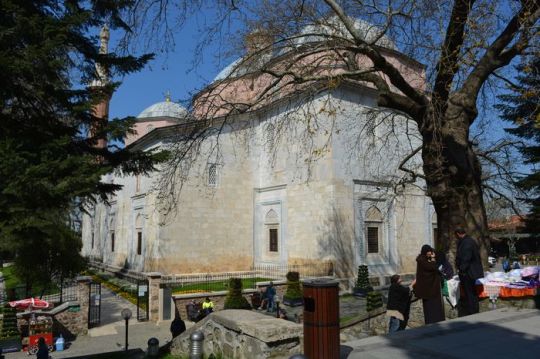
The struggle again the Ottoman Turks
As a young and aggressive power the Ottoman Empire expanded in Asia Minor and soon sought to conquer new lands in the Balkans and in Europe. The first settlement of the Turks on the Balkans dates back to 1352. In 1364 the army of Sultan Murad already penetrated deep in Thrace and seized Plovdiv and Stara Zagora. Meanwhile, the Hungarians launched a powerful offensive from the North-West and the Vi din kingdom fell in their hands. The Turks had planned their march in three strategic directions: along the coast of the Aegean Sea towards Macedonia; along the diagonal of the Balkan Peninsula, heading for Central Europe; towards Dobrudja and the lands beyond the Danube. In 1369 they were already in Adrianople, which became their capital city. In 1371 Tours Bulgaria, after the death of King Ivan Alexander, the united armies of the two Macedonian rulers were defeated. Now the path to the north-west, cutting through the Bulgarian lands, was already open…
Gradually the Turks seized Northern Thrace and the Rhodopes region. Then they penetrated into the North-Eastern Bulgaria, crossing the Balkan Range, and now the Ottoman menace was already imminent for Wallachia and Moldavia. Becoming aware of the danger, the Serbian King Lazar built a Christian coalition, w hich was joined, on the Bulgarian side, only by King Ivan Shishman and Ivanko, the new ruler of Dobrudja. In 1387 the Turks suffered their first, yet sole, defeat. But the battle of Kosovo Pole in the summer of 1389 was of key significance for the fortunes of the Balkan states: they collapsed one after another under the pressure of the Turks…
In 1393 the Turkish military commander Chelebi laid a three-month siege of Tumovo. Finally the city surrendered. The Turks had decided to wipe out the whole population and Patriarch Evtimiy hardly managed to persuade them that for the purpose of imposing their authority it would be sufficient to kill only 111 representatives of the nobility…
0 notes